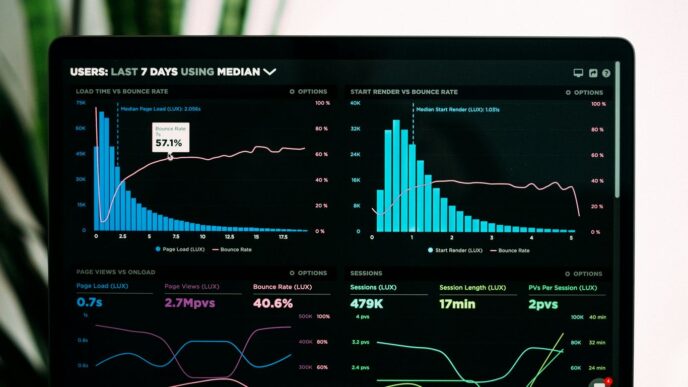Getting your marketing budget for SaaS right in 2025 is super important, especially with how quickly things change. We’re talking about making smart choices to help your company grow. This article will walk you through how to plan your marketing budget for SaaS, making sure every dollar helps you reach your goals.
Key Takeaways
- Market trends mean tighter budgets, so every marketing dollar needs to show clear returns.
- Using AI and automation tools can help stretch your marketing budget for SaaS further by making things more efficient.
- It’s important to put money into both quick wins and long-term strategies, like content, to get the best results.
- Your marketing budget for SaaS should be flexible enough to change based on new information or what competitors are doing.
- The best marketing budget for SaaS always lines up with your company’s bigger plans, whether that’s growing fast or focusing on making more profit.
Budget Implications of Current Market Trends
Tighter Budgets, Higher ROI Expectations
In 2025, SaaS companies are facing a reality where every dollar spent on marketing needs to show clear, measurable returns. This means marketing teams are under more pressure than ever to justify their spending with solid data and demonstrable ROI. It’s not enough to just "do marketing"; now, it’s about doing effective marketing that directly contributes to the bottom line. This shift is partly due to broader economic conditions and a general tightening of belts across industries. Companies are scrutinizing budgets more closely, and marketing is no exception. This environment pushes teams to be more strategic, focusing on channels and campaigns that have a proven track record of success rather than experimenting with unproven tactics. The emphasis is on efficiency and maximizing the impact of every marketing initiative.
AI Integration and Automation
AI isn’t just a buzzword anymore; it’s becoming a fundamental part of marketing operations, and that has direct budget implications. Many SaaS companies are now allocating specific funds to integrate AI tools and automation into their marketing stacks. This includes everything from AI-powered content generation and personalization to advanced analytics that can predict customer behavior. The idea is to use technology to do more with less, automating repetitive tasks and freeing up human marketers to focus on strategy and creativity. This reallocation of funds means less manual labor and more investment in smart tools. For example, a company might invest in:
- AI-driven ad optimization platforms to improve campaign performance.
- Automated customer service chatbots to handle routine inquiries.
- Content creation tools that can draft initial blog posts or social media updates.
- Predictive analytics software to identify high-value leads.
Return of In-Person Events
After a few years where virtual events were the norm, there’s a noticeable swing back towards in-person gatherings. Conferences, trade shows, and industry meetups are making a strong comeback, and SaaS marketers are adjusting their budgets accordingly. There’s a recognition that face-to-face interactions can build stronger relationships and provide unique networking opportunities that virtual platforms just can’t replicate. This means increased spending on:
- Booth rentals and setup at major industry conferences.
- Travel and accommodation for marketing teams attending events.
- Sponsorships for key industry gatherings.
- Promotional materials and giveaways for event attendees.
These events offer a chance to connect directly with prospects and customers, gather feedback, and showcase products in a dynamic environment. Inbound marketing budget considerations are also shifting to include these more traditional, yet effective, channels.
Focus on Existing Customer Revenue
Acquiring new customers has always been a priority, but in 2025, there’s a growing understanding that retaining and expanding revenue from existing customers is just as, if not more, important. The cost of acquiring a new customer continues to rise, making customer marketing and retention strategies incredibly valuable. This shift is reflected in budget allocations, with more funds going towards:
- Customer success initiatives and dedicated account management.
- Upsell and cross-sell campaigns targeting current users.
- Loyalty programs and community building efforts.
- Marketing automation for customer lifecycle management.
This focus acknowledges that a happy, engaged customer base is a stable source of recurring revenue and can also become powerful advocates for the brand, leading to organic growth through referrals and word-of-mouth. It’s about nurturing relationships for long-term value.
SaaS Marketing Budget Formulas and Methodologies
Figuring out how much to spend on marketing can feel like a guessing game for SaaS companies. There are a few common ways to approach it, each with its own pros and cons. It’s not just about picking a number; it’s about making sure that number makes sense for where your business is right now and where you want it to go.
Percentage of Revenue Method
One of the simplest ways to set a marketing budget is by dedicating a percentage of your revenue to it. This method is pretty straightforward: you look at your current or projected income and then allocate a set portion for marketing activities. This approach provides a clear, easy-to-understand baseline for your spending.
- For steady, consistent growth, many companies aim for around 8-10% of their annual recurring revenue (ARR).
- If you’re looking for faster growth, you might increase that to 15-20%.
- During aggressive growth phases, especially for newer companies or those entering new markets, it’s not uncommon to see budgets as high as 20-40% of revenue.
This method is popular because it scales with your business. As you make more money, your marketing budget grows, allowing you to invest more in customer acquisition. However, it can also be a bit limiting if you’re in a period of rapid expansion and need to spend more than your current revenue might suggest.
Competitive Landscape Considerations
Your competitors’ spending habits can also influence your marketing budget. It’s not about blindly copying them, but understanding what others in your space are doing can give you a sense of the investment required to compete effectively. The SaaS market is pretty crowded these days, so standing out often means putting money into things like brand building, content, and targeted campaigns. This pressure can push marketing spend up, especially if you’re trying to become a leader in your niche.
- Analyze competitor marketing spend (where possible) to gauge industry norms.
- Consider the saturation of your market; highly competitive markets often demand higher marketing investment.
- Factor in the cost of acquiring a customer in your specific industry.
Growth Expectations and Investor Demands
How fast you want to grow, and what your investors expect, plays a huge role in your marketing budget. If you’re a startup backed by venture capital, investors are usually looking for rapid expansion. Meeting those expectations often means a significant investment in marketing, especially in the early stages. It’s a bit of a cycle: investors put money in, expecting growth, and that growth often requires more marketing spend. Even with new technologies like AI, getting more customers usually means spending more, especially as you start to saturate a market. For a deeper look into how different funding stages impact budget allocation, consider exploring SaaS marketing budget strategies.
- Align your marketing budget with your overall business growth targets.
- Understand investor expectations for customer acquisition and revenue growth.
- Be prepared to adjust your budget based on funding rounds and strategic shifts.
Practical Tips for Optimizing Your SaaS Marketing Budget

It doesn’t matter how big your marketing budget is; you can always make it work harder. The goal is to get the most bang for your buck, right? So, let’s talk about some real-world ways to make your marketing dollars go further.
Prioritize High-ROI Channels
Look, not all marketing channels are created equal. Some just work better for your specific SaaS product than others. You’ve got to figure out which ones are pulling their weight and which ones are just… there. The smart move is to put more money into the channels that are actually bringing in customers and revenue. This means digging into your data, seeing what’s converting, and then doubling down on those winners. If paid search is crushing it, maybe shift some budget from that social media campaign that’s just getting likes but no sign-ups. And hey, don’t be afraid to try new things, but do it carefully, with a small test budget first.
Balance Short-Term and Long-Term Investments
It’s easy to get caught up in the immediate wins, like those quick leads from a paid ad campaign. And sure, those are important for hitting your quarterly goals. But you also need to think about the long game. Things like search engine optimization (SEO) and content marketing might not give you instant results, but they build up over time, creating a steady stream of organic traffic and leads. It’s like planting a tree versus buying a bouquet of flowers. Both have their place. You need a mix: some budget for the immediate stuff, and some for building that long-term foundation. For example, you might allocate:
- Short-Term (Quick Wins):
- Paid advertising (PPC, social media ads)
- Promotional email campaigns
- Limited-time offers
- Long-Term (Sustainable Growth):
- Content creation (blog posts, whitepapers, videos)
- SEO efforts (keyword research, technical SEO)
- Community building and engagement
Leverage Marketing Technology
In 2025, if you’re not using technology to make your marketing more efficient, you’re just leaving money on the table. There are so many tools out there that can automate tasks, give you better insights, and generally make your life easier. Think about marketing automation platforms that can nurture leads, or analytics tools that show you exactly where your customers are coming from. AI tools are also becoming a big deal, helping with everything from content generation to ad optimization. Investing in the right tech can help you do more with less, stretching your budget further than you thought possible. For instance, consider tools for:
- Customer Relationship Management (CRM)
- Marketing Automation
- Analytics and Reporting
- PPC success and Ad Management
- Content Management Systems (CMS)
Implement Rigorous Testing and Optimization
This is where a lot of companies fall short. They set up a campaign, let it run, and then wonder why it’s not performing. You can’t just set it and forget it. You need to be constantly testing, tweaking, and optimizing. This means setting aside a portion of your budget specifically for A/B testing. Test different ad copy, different landing page designs, different email subject lines. Even small improvements in your conversion rates can have a huge impact on your overall marketing efficiency. It’s all about continuous improvement. Here’s a simple testing process:
- Formulate a Hypothesis: What do you think will happen if you change something?
- Design the Test: Create two versions (A and B) of your ad, landing page, etc.
- Run the Test: Show both versions to a segment of your audience.
- Analyze Results: See which version performed better based on your metrics.
- Implement Changes: Apply the winning version and then test something else.
Finding Your SaaS Marketing Budget Sweet Spot
Figuring out the right amount to spend on marketing for your SaaS company isn’t a one-size-fits-all deal. It really depends on where your business is right now and what you’re trying to achieve. Your marketing budget needs to align with your overall business goals, whether that’s steady growth, rapid expansion, or something in between. It’s not just about throwing money at campaigns; it’s about smart, strategic allocation.
Baseline for Steady Growth
If your SaaS company is looking for consistent, manageable growth without breaking the bank, a baseline approach is probably what you need. This usually means allocating a percentage of your current or projected revenue to marketing. It’s a conservative but effective way to keep the lights on and acquire new customers at a sustainable pace. Think of it as maintaining a healthy pulse for your business.
- Typically, this involves setting aside around 8-10% of your annual recurring revenue (ARR) for marketing activities.
- This budget level supports ongoing demand generation, content creation, and customer retention efforts.
- It allows for incremental improvements in your marketing channels without significant risk.
Accelerated Growth Investment
When your SaaS business is ready to kick things into a higher gear and you’re aiming for faster expansion, you’ll need to increase your marketing investment. This phase is about pushing boundaries and capturing a larger market share. It often means being more aggressive with paid channels and expanding into new territories or customer segments. It’s a calculated risk for a bigger reward.
- For accelerated growth, a common range is 15-20% of your ARR dedicated to marketing.
- This higher percentage enables more significant investment in paid media, strategic partnerships, and market penetration campaigns.
- It supports scaling up your marketing team and technology stack to handle increased volume.
Aggressive Growth Phases
For SaaS companies in an aggressive growth phase, often backed by significant investment or aiming to dominate a new market, the marketing budget can be quite substantial. This isn’t about steady progress; it’s about rapid, sometimes explosive, expansion. It requires a willingness to spend big to win big, often prioritizing market share over immediate profitability. This is where you really lean into customer acquisition.
- During aggressive growth, marketing budgets can range from 20-40% of ARR, or even higher in specific cases.
- This level of investment allows for extensive brand building, aggressive customer acquisition campaigns, and rapid market saturation.
- It often involves significant spending on experimental channels and new market entry strategies.
- For B2B companies, understanding the B2B marketing budget is key to this aggressive approach.
Strategic Allocation of Your Marketing Budget
Figuring out where your marketing money goes is just as important as knowing how much you have. It’s not just about throwing cash at everything; it’s about being smart with every dollar. You want to make sure each part of your marketing machine gets what it needs to run well and help your company grow.
People and Internal Marketing Team Investment
Your team is the backbone of your marketing efforts. A big chunk of your budget, often around 45-55%, goes to salaries, benefits, and contractors. Marketing is a human-intensive field, so it makes sense that nearly half of your spending supports the people who are actually doing the work. This includes everyone from content creators to campaign managers and data analysts. Investing in your team means they have the resources and stability to perform at their best. It’s not just about paying them; it’s about training, tools, and making sure they have what they need to succeed.
Demand Generation and Paid Media Allocation
This is where you actively go out and find new customers. Typically, about 15-20% of your budget lands here. This covers a lot of ground:
- Paid advertising, like PPC search ads and paid social campaigns, gets your message in front of people who are already looking for solutions.
- Account-based marketing (ABM) focuses on specific high-value accounts, tailoring your approach to their unique needs.
- Outbound email campaigns are still a thing, helping you reach prospects directly.
- SEO efforts, while often seen as organic, require investment in tools and expertise to make sure your content ranks well and brings in traffic. SaaS-based Business Intelligence tools can help track the effectiveness of these campaigns.
Content Marketing Investment
Content marketing is about building trust and authority over time. It usually takes up a smaller slice of the pie, around 5-7% for established companies, but it’s super important for long-term growth. This includes:
- Creating blog articles, whitepapers, ebooks, and case studies that educate your audience.
- Producing videos and webinars that engage prospects and explain complex topics.
- Promoting and distributing your content across different channels to make sure it gets seen by the right people. Early-stage startups might put more money into content, sometimes 20-40%, because it’s a great way to generate inbound leads when you’re just starting out.
Building Flexibility into Your Marketing Budget
Things change fast in the SaaS world, and your marketing budget needs to keep up. Sticking to a rigid plan from January 1st to December 31st is just asking for trouble. You need to build in some wiggle room, some give, so you can react to new opportunities or unexpected challenges. Think of it like having a financial safety net, but for your marketing efforts. A flexible budget lets you pivot quickly, whether that means jumping on a hot new trend or pulling back from something that isn’t working. It’s about being agile, not just reactive.
Experimentation and Contingency Planning
It’s smart to set aside a portion of your budget specifically for trying new things. This isn’t just about throwing money at the wall; it’s about controlled experiments. Maybe 10-15% of your total budget could be earmarked for testing out a new ad platform, a different content format, or even a niche influencer campaign. If it works, great, you can scale it up. If it doesn’t, you haven’t blown your entire budget.
- Allocate 10-15% of the budget for new channel tests.
- Develop clear success metrics for each experiment.
- Have a plan for what to do if a channel underperforms.
- Consider a small reserve for unforeseen market shifts.
This also ties into contingency planning. What if a major competitor launches a huge campaign? What if a key marketing channel suddenly becomes way more expensive? Having a small buffer allows you to respond without completely derailing your existing plans. It’s like having an emergency fund for your marketing.
Quarterly Reassessment and Reallocation
Don’t just set your budget and forget it. The market, your customers, and even your own product can change significantly over a few months. That’s why quarterly reviews are so important. Look at your performance data, see what’s working and what’s not, and then be ready to shift funds around. Maybe your paid social campaigns are crushing it, but your email marketing isn’t quite hitting the mark. You can move some money from email to social to maximize your impact. This isn’t about being indecisive; it’s about being smart and data-driven.
Here’s a simple framework for quarterly reviews:
| Quarter | Review Date | Key Performance Indicators (KPIs) | Budget Adjustments | Notes |
|---|---|---|---|---|
| Q1 | March 25 | Lead Gen, CAC, MQLs | +5% to Content, -3% to Display Ads | Content performing well, display ads underperforming. |
| Q2 | June 25 | Conversion Rates, SQLs, Churn | +7% to Paid Search, -4% to Events | Strong ROI from paid search, events not yielding expected leads. |
| Q3 | September 25 | Customer Lifetime Value, Upsells | +6% to Customer Marketing, -2% to SEO | Focus on existing customer growth, SEO showing slower returns. |
| Q4 | December 25 | Overall ROI, Brand Awareness | Reallocate based on annual goals | Final adjustments for year-end push and next year’s planning. |
This regular check-in helps you stay on track and ensures your money is always going to the most effective places. It’s a continuous improvement loop.
Responding to Competitive Moves
In the SaaS world, competition is fierce. Your rivals aren’t sitting still, and neither should you. If a competitor launches a new product, drops their pricing, or starts a massive ad campaign, you need to be able to react. This might mean increasing your ad spend in certain areas, launching a counter-campaign, or even investing more in software outsourcing to quickly develop new features that differentiate your product. Having a flexible budget means you’re not caught flat-footed. You can quickly allocate resources to defend your market share or even seize new opportunities that arise from competitive shifts. It’s about being proactive, not just reactive, to the ever-changing landscape.
Aligning Marketing Budget with Business Strategy
Making sure your marketing budget lines up with your overall business strategy is super important for SaaS companies. It’s not just about spending money; it’s about investing it in a way that pushes the company toward its big goals. If marketing is off doing its own thing, even if it’s getting good results, it might not be helping the business where it really counts. So, every dollar spent on marketing should have a clear connection to what the company is trying to achieve, whether that’s rapid growth, steady profitability, or breaking into new markets.
Growth Versus Profitability Focus
Deciding whether to chase growth or focus on profitability is a big strategic choice that directly impacts your marketing budget. If the company is all about rapid growth, the marketing budget will likely be larger and aimed at aggressive customer acquisition. This means more spending on things like paid ads, content that generates leads, and expanding into new customer segments. On the flip side, if the focus is on profitability, the marketing budget might be tighter, with a stronger emphasis on retaining existing customers, increasing their lifetime value, and optimizing spend for the highest possible return. It’s a balancing act, and the marketing team needs to know which way the company is leaning to allocate funds effectively.
Here’s a quick look at how these focuses might shift budget priorities:
| Strategic Focus | Marketing Budget Implication |
|---|---|
| Aggressive Growth | Higher spend on new customer acquisition, brand awareness, market penetration. |
| Profitability | Increased investment in customer retention, upsells/cross-sells, efficiency, and optimizing existing channels. |
Expansion Plans and Product Roadmap
Your company’s expansion plans and product roadmap are huge drivers for marketing budget decisions. Are you launching a brand new product? Entering a new geographic market? Targeting a completely different customer segment? Each of these scenarios requires specific marketing support and, consequently, budget allocation. For example, a new product launch might need a significant chunk of change for awareness campaigns, early adopter programs, and content explaining its value. Expanding into a new region means budgeting for localized marketing efforts, understanding new competitive landscapes, and potentially hiring local marketing talent. The marketing budget isn’t just a standalone number; it’s a reflection of these forward-looking business initiatives. It’s about making sure marketing is ready to support every new venture the company takes on.
Investor Expectations and Funding Environment
The expectations of your investors and the current funding environment play a pretty big role in shaping your marketing budget. If you’re a startup that just secured a big funding round, investors might expect aggressive growth, which means a larger marketing budget to fuel that expansion. They’ll be looking for clear metrics on customer acquisition cost (CAC) and customer lifetime value (LTV) to see if their investment is paying off. On the other hand, in a tighter funding environment, investors might push for more capital efficiency and a clearer path to profitability, which would lead to a more conservative marketing budget focused on high-ROI channels and measurable returns. Understanding these external pressures is key for marketing leaders to justify their spend and show how it aligns with the financial realities and expectations of those who are funding the business. It’s all about showing how marketing contributes to the overall financial health and future prospects of the company.
Wrapping Things Up
So, figuring out your SaaS marketing budget for 2025 isn’t just about picking a number. It’s more about really knowing your business, what you want to achieve, and how the market is looking. The goal is to spend smart, not just spend a lot. By keeping an eye on what works, being ready to change things up, and making sure every dollar helps you grow, you can set your SaaS company up for some real success. It’s all about being clever with your money, not just throwing it around.
Frequently Asked Questions
How much of my budget should I save for trying new things and for emergencies?
It’s smart to set aside about 10-15% of your marketing budget for trying out new things and for unexpected problems. This way, you can test new ideas and also have money ready if something doesn’t go as planned.
How often should I check and change my marketing budget?
You should look at your budget every three months. This lets you see what’s working and what’s not, so you can move money around to the things that are doing best.
How does what my competitors do affect my marketing budget?
When competitors make big moves, you might need to adjust your budget to keep up. This could mean spending more on certain ads or campaigns to stay competitive.
How does my marketing budget connect with my company’s overall plans?
Your marketing budget should always match your main business goals. For example, if you want to grow really fast, you’ll need to spend more on marketing. If you’re focusing on making more profit, you might spend less but more wisely.
Does my marketing budget need to change as my company gets bigger?
Yes, your marketing budget needs to change as your company grows. What works for a small startup won’t work for a big, established company. You’ll need to spend more and on different things as you get bigger.
How do investors and the money they give affect my marketing budget?
The money you get from investors can really change your marketing budget. If you have a lot of investor money, you might be able to spend more to grow faster. If not, you’ll need to be more careful with every dollar.














